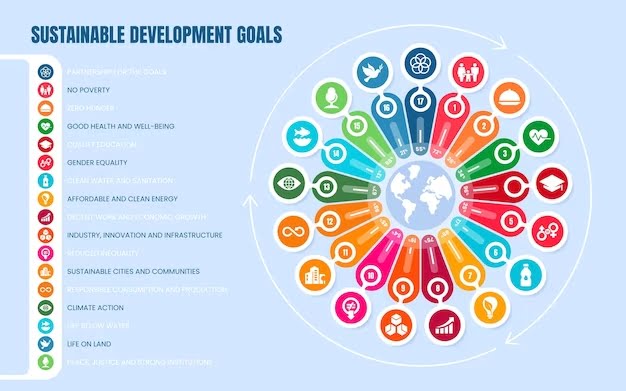SDGs: A Practical Guide
In the present-day quickly changing business landscape, sustainability has become more than a term. It is a guiding concept that shapes the destiny of enterprises all over the world. The Sustainable Development Goals (SDGs) are at the center of this movement. They are a collection of 17 global objectives developed by the United Nations to address major social, environmental, and economic concerns. Businesses are increasingly understanding the value of aligning with these objectives. This is in order to generate good change and contribute to a more sustainable future. In this thorough book, we’ll look at the SDGs in detail. We’ll also present SDGs: A Practical Guide showing practical solutions for businesses to properly navigate and incorporate them into their operations.

Understanding the Sustainable Development Goals
The Sustainable Development Goals (SDGs) serve as a road map for solving some of humanity’s most serious issues. These issues include poverty, hunger, climate change, and inequality. Understanding the SDGs allows businesses to connect their activities with global sustainability goals and contribute to significant progress. Each of the 17 objectives includes precise targets and metrics to achieve a more sustainable and equitable society by 2030. Goal 1 seeks to eradicate all forms of poverty. Goal 13 focuses on immediate action to prevent climate change and its consequences. Businesses that get familiar with the SDGs can identify areas where they can have the most effect. They can then build tailored plans to meet them.
Furthermore, the SDGs establish a common vocabulary and structure for collaboration across enterprises, governments, and civil society groups. By banding together around common aims and objectives, stakeholders may combine their resources, skills, and networks to better address difficult sustainability concerns. Understanding the SDGs creates opportunities for collaborations and collective action. This allows businesses to use their combined power and resources to effect good change on a global scale. Businesses that embrace the SDGs may present themselves as responsible corporate citizens. They are committed to promoting sustainable development and making a positive influence in the world.
Why Businesses Should Care About the SDGs
Businesses have an important role in attaining the SDGs because of their economic power, innovative skills, and operational reach. Businesses that align their strategy with the SDGs can not only contribute to societal and environmental well-being. They can also reap a variety of benefits. One important reason why companies should be concerned about the SDGs is the rising demand from customers, investors, and other stakeholders for responsible and sustainable business operations. As people become more conscious of global issues like climate change, inequality, and social injustice, they become more picky about whose firms they support and buy from.
Furthermore, embracing the SDGs may boost a company’s brand reputation and set it apart from competitors in the market. Businesses that prioritize sustainability and good business practices are more likely to attract and keep consumers, investors, and top personnel. Furthermore, incorporating the SDGs into corporate operations may spur innovation and operational efficiency. This can result in cost savings, new market possibilities, and greater resilience. Companies that align with the SDGs may future-proof their operations, reduce risks, and position themselves for long-term success in a constantly changing world.

Practical Strategies for Integrating SDGs into Business Operations
While the SDGs may appear overwhelming at first, businesses of all sizes and industries can take practical efforts to integrate them into their operations. Here are some practical ways to get you started:
- Conduct a Materiality Assessment: Begin by determining which SDGs are most important to your business and stakeholders. Conduct a materiality evaluation to prioritize goals that are consistent with your company’s beliefs, key capabilities, and impact areas.
- Set Clear Goals and Targets: Once you’ve chosen your top SDGs, make specific and quantifiable objectives and targets for each. Define Key Performance Indicators (KPIs) to monitor progress and maintain accountability.
- Integrate SDGs into Business Strategy: Incorporate the SDGs into your company’s strategy, mission statement, and core values. Ensure that sustainability issues are factored into decision-making processes at all levels of the company.
- Collaborate and Engage with Stakeholders: Encourage collaboration among internal and external stakeholders, including as workers, customers, suppliers, and local communities. Engage stakeholders in communication and collaboration to develop solutions that solve common sustainability concerns.
- Measure and Report Progress: Regularly monitor and analyze your progress toward SDG objectives. Implement effective monitoring and reporting procedures to clearly convey your accomplishments, difficulties, and lessons gained.
FAQs
🤔 How does transparency benefit businesses?
Answer: Aligning with the SDGs allows businesses to generate good change and increase competitiveness, so contributing to a sustainable future. Businesses that include sustainable development goals can enhance their social and environmental impact while increasing performance.
🤔 What role does Fherist play in promoting corporate transparency?
Answer: Businesses increase their competitiveness by aligning with the SDGs and capitalizing on possibilities for innovation and market expansion. Integrating sustainable development goals into strategies promotes resilience and long-term success in a changing environment.
🤔 Can transparency help companies attract investors?
Answer: SDG alignment enables businesses to drive good change, such as lowering carbon emissions and increasing social fairness. Companies that adopt sustainable development goals may have a significant influence on communities and ecosystems.
🤔 How do companies demonstrate transparency in their operations?
Answer: Businesses play an important role in ensuring a sustainable future by aligning with the SDGs and encouraging collective action. Companies help to achieve global goals and build resilience to new threats through ethical practices and collaborations.
🤔 What are some real-world examples of companies that have successfully leveraged transparency?
Answer: Aligning with the SDGs is critical for businesses to stay relevant and succeed in a continuously changing environment. Companies that embrace sustainable development goals may improve their reputation, reduce risks, and open up new prospects for growth and influence.

Fherist: SDGs practical guide
Fherist provides a complete platform for businesses. They are looking to incorporate the Sustainable Development Goals (SDGs) into their operations and have a real impact via a comprehensive SDGs practical guide. As a company directory, marketplace, and certification platform, Fherist provides a variety of tools and services to help businesses on their sustainable path. Businesses using Fherist’s services receive access to a varied ecosystem of sustainability programs, partners, and opportunities. These resources are tailored to their individual requirements and objectives.
Fherist’s company directory is a crucial component. It allows companies to claim or add sustainability-related entries for free or through paid memberships. This list is an invaluable resource for businesses wishing to connect with like-minded partners, suppliers, and service providers. They are committed to furthering the SDGs. Fherist also provides certification for organizations that demonstrate a commitment to ESG reporting and the UN Sustainable Development Goals. This increases their credibility and transparency in the market.
Conclusion
In summary, incorporating the Sustainable Development Goals into corporate operations is a moral obligation. It is also a strategic need in today’s complicated and interconnected world. Businesses that align with the SDGs practical guide may generate positive change and increase their competitiveness. They also help to create a more sustainable future for everyone. Businesses can traverse the SDGs with confidence and purpose by implementing realistic strategies and leveraging platforms like Fherist.








